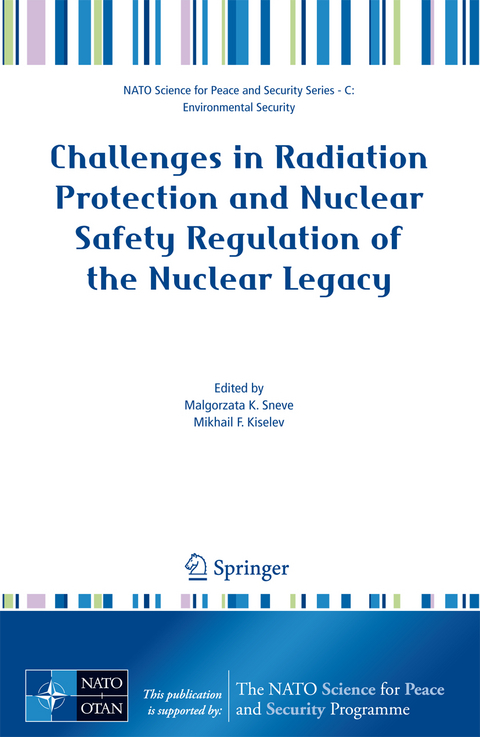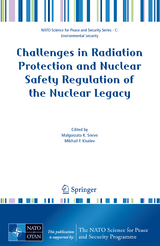Challenges in Radiation Protection and Nuclear Safety Regulation of the Nuclear Legacy
Springer-Verlag New York Inc.
978-1-4020-8632-8 (ISBN)
A NATO workshop was held in September 2007 under the Security through Science framework to consider the current challenges in regulation of the nuclear legacy. The overall objective was to share East-West competence and experience in radiation protection and nuclear safety supervision of installations built during the cold war, particularly in relation to regulatory strategies for safe decommissioning of unique or unusual nuclear facilities and remediation activities.
There were over 60 participants from 8 countries as well as representatives from the International Commission on Radiological Protection, the International Atomic Energy Agency and NATO. The organisations involved included regulatory authorities, operators and technical support organizations.
The new Russian Federation Unified State Programme for Handling Spent Fuel and Radioactive Waste was introduced and the steps necessary to set this up as a comprehensive programme of activities were described. Some waste management sites are in a poor state. Legacy management experience was provided from the UK, France and the USA. Information was provided on methods for site characterisation and separation of wastes into exempt, low-level and intermediate level waste, and the complication of dealing at the same time with chemical hazards, such as beryllium. Strategies for contaminated site management were also explained and the associated risk assessment methods outlined.
The Russian Federation has responsibility to manage its own nuclear legacy. But it is also one of several countries in the global network of nuclear activities. Harmonisation of approaches is valuable in building future cooperation, but local conditions may influence the best local solution. Accordingly, future exchanges, such as those provided for by this workshop, should be encouraged.
There are many complex issues to be addressed and they cannot all be solved at once. Clear recognition of the major threats,as well as weakness in regulatory processes, can be useful in directing future resources. However, at this stage it is clear that there are specific regulatory issues to address as well as a need to maintain development of an enhanced overall safety culture.
Such guidance needs to be thoroughly based on the best use of scientific and technical information. At the same time, part of the solution relates to policy issues and value judgements, and so broader interaction among regulators, operators and other stakeholders is to be encouraged.
Introduction, Summary and Conclusions of the NATO Workshop.- International Cooperation of FMBA RF Aimed at Radiation Safety Assurance in Northwest Russia When Solving Nuclear Legacy Challenges.- Welcome of Federal Atomic Energy Agency.- NATO Support to Non-military, Civil Science for Peace and Security.- – Norwegian Perspective on Nuclear Legacy.- Session I Nuclear Legacy Challenges.- Issues in Decommissioning and Remediation of Nuclear Legacy Sites.- Unified State System of Management Spent Nuclear Fuel and Radioactive Waste. Conceptual Approaches and Generation Principles.- Nuclear Legacy Problems and Their Solutions Within the Federal Target Program «Nuclear and Radiation Safety Assurance for 2008 and for the Period Till 2015».- Strategy for Russian-Norwegian Regulatory Cooperation.- Session II Regulatory Implementation of Treaties, Standards and Recommendations.- Scientific Support for Cooperation Between Regulators and Operator (2006 and First Half of 2007).- Strategy for the Environmental Regulation of Remediation and Decommissioning at Sellafield.- State Supervision of Nuclear and Radiation Safety During Dismantlement of Decommissed Nuclear Powered Ships and Remediation of Former Shore Technical Bases of the Northern Fleet.- Philosophy of the Occupational and Public Radiological Protection in the Regulation of the Nuclear Legacy.- Session III Challenges in Practical Implementation of Remediation Strategy in Russia and Abroad.- Regulation at Hanford – A Case Study.- Features of Solving the Problems of Remediation of “Sevrao” Facilities: Strategic Planning of Ecological Remediation of the Facility for Spent Nuclear Fuel and Radiation Waste Temporary Storage in Gremikha.- Transport-Technological Scheme of High-Level SRW Management from the ReactorFacilities in the Northwest Russia.- The Techa Reservoir Cascade: Safety and Regulation Problems.- Restoration Principles and Criteria: Superfund Program Policy for Cleanup at Radiation Contaminated Sites.- Session IV Safety Regulation Experience in Russia and Abroad.- Challenges in Radiation Safety Regulation with Respect to Supervision of FSUE “SevRAO” Facilities.- Regulative Provision of Waste Management Regulatory Supervision at SevRAO Facility.- Regulatory Case Studies and Western Experience Concerning Nuclear Legacy.- About Activity of the Federal Medical Biological Agency in the Field of the State Safety Regulation at Atomic Energy Use.- Radiation Protection of the Public and Environment Near Location of SevRAO Facilities.- Special Features of the Personnel Radiation Protection Assurance During SNF and RW Management at SevRAO Facilities.- Regulatory Control of Radioactive Waste in Sweden.
| Erscheint lt. Verlag | 15.7.2008 |
|---|---|
| Reihe/Serie | NATO Science for Peace and Security Series |
| Zusatzinfo | XIII, 236 p. |
| Verlagsort | New York, NY |
| Sprache | englisch |
| Maße | 155 x 235 mm |
| Themenwelt | Naturwissenschaften ► Biologie ► Ökologie / Naturschutz |
| Naturwissenschaften ► Physik / Astronomie ► Angewandte Physik | |
| Technik ► Umwelttechnik / Biotechnologie | |
| ISBN-10 | 1-4020-8632-6 / 1402086326 |
| ISBN-13 | 978-1-4020-8632-8 / 9781402086328 |
| Zustand | Neuware |
| Haben Sie eine Frage zum Produkt? |
aus dem Bereich




